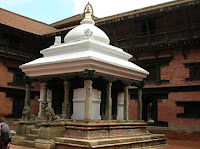Kathmandu is a capital city of Nepal. The name Kathmandu is derived from the "wooden structure" called Kasthamandapa (The house of wood) . The city has another name Kantipur, used in the past. Kathmandu is the full of living cultural heritage and monuments. Therefor, it is also known as the city of temples and house of Gods. Four sites of city are enlisted in World Heritage Sites of UNESCO in 1979 AD. These are :
1) Kathmandu Durbar Square.
Kathmandu Durbar Square is full from the medieval architectural monuments. Here, we find beautiful shrines and monuments with fabulous art; dated from 12th century A.D to 19 the century. The ancient royal palace, Hanuman Dhoka was used by Malla Dynasty from 15th to 18th century A.D Kumari Bahal, the house of living Goddess - is the superb example of Nepali architecture & house of living Goddess in Nepal. Kasthamandapa, Taleju temple, Hanuman dhoka, Basantapur palace and many monuments are already in the World Heritage Site of UNESCO on 1979AD.
2) Swoyambhunath
Swoyambhu Nath is the pre-historic Buddhist stupa (chaitya) of antiquity & situated in the hillock. It has not only religious sanctity but also stands as a typical example of the Nepali stupa architecture. Swoyambhu (the self-existent one) was existed as a lotus flower when Kathmandu was a big lake in the ancient time. The site was registered in World Heritage Site of UNESCO in 1979AD. This temple is also known as Monkey temple among the tourists in Nepal. Walking tour to Swayambhunath from Kathmandu is quite popular with its 365 ascending steps of main entrance gate.
3) Pashupatinath:Pashupani Nath temple is dedicated to Lord Shiva as the God of all living beings. Pashupati Nath is a one of the most sacred site for Hindus in Nepal. Lord Shiva is the most worshiped God in the Hindu world as the God of the Gods & power of destruction & recreation with His Phallic form. The temple is in pagoda architecture with gold plated roofs, four silver doors and fine wood carvings on it.There is a gold plated statue of large Nandi (Bull) on the western door of the temple.Near of the temple there is a sacred river bagmati along this river there are cremation grounds for the Hindus. The site was also registered in World Heritage Site of UNESCO on 1979 AD. This site is quite popular for the colorful Sadhus (Holy men) and Hindu Sanskar.
 4) Bauddhanath:
4) Bauddhanath: Bauddhanath is the biggest stupa of Nepal & one of the biggest in the world. This place is known as the center of Tibetan Buddhism in Kathmandu. Surrounded by spectacular Baudha stupa, there are more than 35 Buddhist monasteries belongs to different schools of Tibetan Buddhism. It is believed that this 46 m. high stupa was constructed in 5th century A.D and registered in World Heritage Site of UNESCO on 1979 A.D.
Click for more: www.travelsupportnepal.com























